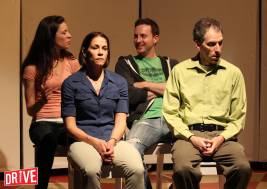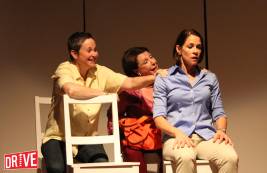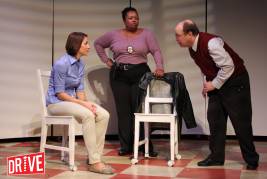RECOMMENDED
Drive, Laura Black’s World Premiere comedy-drama running Wednesdays at Open Fist Theatre, starts out as its title suggests with a road trip, its lead character Peggy (Jane Hajduk) traveling up the I-5 with a pair of longtime lesbian friends. Only her frequent asides to the audience cue us in to the fact that things may not be as clear-cut as they might seem on the surface.
40something Peggy’s traveling companions are Agnes (Susan Sommer) and Estelle (Beth Robbin), a lovably oddball middle-aged couple who’ve never officially come out to their married, heterosexual friend. The trio’s drive is kept lively with Agnes and Estelle’s affectionate bickering, the backseat pair sharing sips from Agnes’s flask. Then, without warning, there’s the sound of brakes screeching and horns blaring. The three ladies lurch, then lurch again. More horns blare, then fade, allowing the trio to settle back into their seats. A relieved Peggy turns around to ask for a small sip of whatever Agnes has in her flask, at which time lights blaze white, sounds of crashing metal shatter the calm, and the next thing Peggy knows, she’s waking up in a hospital room.
It soon becomes clear to the injured driver, and to us as audience members, that Peggy’s situation may be a good deal more complicated than a simple recovery from a car crash. Agnes and Estelle keep popping up in her hospital room without need of a door, then disappear whenever a doctor or nurse is around. All of a sudden, Peggy finds herself back home at the kitchen table with husband Jack (Barry Saltzman) and college-age twins Denny (Allison Mattox) and Dash (Coronado Romero). A flash of pain shoots up her back and lo-and-behold the nurse (AlgeRita Wynn) is back, Agnes and Estelle not far behind.
Next Peggy’s in her office taking care of phone business, Denny and Dash frustrated by their inability to get Mom’s attention. The twins’ exit prompts the return of the lesbians, the only two people who seem to have any real connection with Peggy since the crash. We’re then back in Peggy’s car just before the accident, only this time she’s trying to get out of the car with Agnes and Estelle doing their best to hold her down, after which Peggy’s being helped out of her vehicle by Denny, Dash, and the nurse and led back to her hospital bed.
And Peggy’s “Drive” has just begun.
Playwright/director Black’s program note informs us that the inspiration for Drive came from a random conversation with an accident victim who’d suffered a serious memory loss extending to loss of identity. Taking this real-life event as a starting point, Black has concocted a highly imaginative fictionalization of that traumatic experience, one that seems made for the silver screen, its many scene and locale changes proving problematic to the medium of live theater, at least as currently staged.
Drive has a lot going for it, not the least of which is Black’s clever dialog and imaginative, non-linear plot. The mystery surrounding Peggy’s condition grabs one’s attention from the get-go, and an end-of-Act One blackout sends the audience out for an intermission certain to be filled with eager comparing of notes.
To be completely successful as a theatrical production, however, Drive needs a more seamless staging than it now has. I would be hard-pressed to count how many times all-purpose chairs and tables (and Peggy’s hospital bed) are rolled onstage and then off and then on again by actors silhouetted in light coming from behind upstage curtains, each and every instance of this taking the audience out of the moment. In a nutshell, transitions that may have seemed easily stageable on paper end up considerably more problematic in actuality.
A couple solutions come to mind. Various parts of the stage might be reserved for each of the script’s various locations, thereby eliminating most of the need to move set pieces. My theater companion suggested an alternate solution, keeping furniture down to a handful of chairs and letting our imagination do the rest. Either way would keep the pace swifter and the audience more consistently connected to Peggy’s story.
For the most part, the acting cannot be faulted. Hajduk does solid work as Peggy, striking a nice balance between confusion and spunk, and Saltzman is effective as her husband, as are Mattox and Romero as her children (though a younger-looking actor would have been more believable as the still adolescent, or at least adolescent-acting Dash). Joseph Beck is amusingly officious as Peggy’s doctor and psychiatrist. Wynn’s tentative performance as both nurse and policewoman, on the other hand, could benefit from a good deal more pep and prep. Sommer and a particularly authentic Robbins are an absolutely delight as Estelle and Agnes, playwright Black deserving snaps for taking a couple who could just as easily have been written as platonic friends, or as a male-female couple, making them gay, and making their sexual orientation a casually introduced non-issue.
Set decorator/designer Valda Lake has done a nice job camouflaging the mainstage Curse Of The Starving Class set to fit Drive’s needs, though as stated earlier, a different use of the stage area would make for smoother between-scene transitions. Kathi O’Donohue’s lighting design is laudably complex for a production which runs only once a week. Garrard Whatley’s excellent sound design has just the right mix of car crash noises, hospital beeps, and other assorted effects. Martha Demson is artistic director for Open Fist Theatre. Daniel Escobar is stage manager and Derek Manson assistant stage manager.
Though Drive doesn’t come across as effectively on stage as it reads on paper—at least in its current incarnation, it nonetheless marks the beginning of what will hopefully be a fruitful collaboration between playwright-managed theater company Playwrights 6 and the much esteemed Open Fist Theatre Company. (See footnote.) With few midweek options available to theater aficionados, Drive’s arrival is definitely one to applaud.
Open Fist Theatre, 6209 Santa Monica Blvd., Hollywood.
www.openfist.orgwww.playwrights6.org
–Steven Stanley
May 4, 2011





 Since 2007, Steven Stanley's StageSceneLA.com has spotlighted the best in Southern California theater via reviews, interviews, and its annual StageSceneLA Scenies.
Since 2007, Steven Stanley's StageSceneLA.com has spotlighted the best in Southern California theater via reviews, interviews, and its annual StageSceneLA Scenies.







 COPYRIGHT 2024 STEVEN STANLEY :: DESIGN BY
COPYRIGHT 2024 STEVEN STANLEY :: DESIGN BY